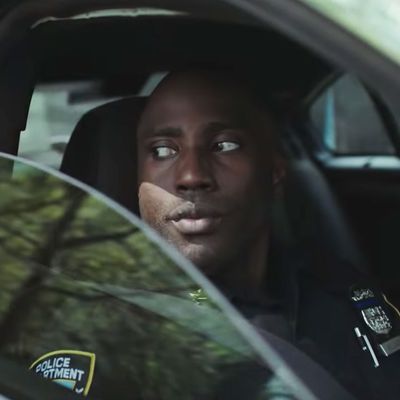
Monsters and Men is a rather straightforward ripped-from-the-headlines story. But it’s aided by a narrative structure that highlights complexity, rather than tidy symmetry. Each of the film’s three acts follow a different character in the Bed-Stuy neighborhood in which the police shooting of Darius Larson takes place. First, we follow Manny Ortega (Anthony Ramos), a young man whose phone video of the shooting brings national attention to the case, and also lands him rather unjustly in jail. Then we follow Dennis (John David Washington), a black cop in the same precinct as Larson’s shooter, who has to reckon with his role in the community and how complicit he is in the violence his peers engage in. The third section follows a young high-school athlete (Kelvin Harrison Jr.) who is pulled between the activism and movement formed around Larson’s death and his own prospects as a baseball pro.
All three of these story lines lack resolution — perhaps because in the year of our lord 2018, we in the theater don’t know how this story ends, aside from perhaps some burning faith in the long arc of the moral universe. Monsters and Men, then, functions more as a lightly fictionalized photo essay than a narrative film — which is okay, it just means that it feeds more off timeliness than character or art, and there are obvious limitations to that. Reinaldo Marcus Green’s direction is emotionally focused (particularly Harrison’s story line), if not a little understated, and Patrick Scola’s cinematography is tasteful and sufficiently weighty. This is a respectable picture that takes few chances.
One of the few chances that it does take is with Washington’s section. What is it about the actor, still in the early breakout stages of his career, that screams to casting directors “cop”? The somewhat lost, cagey presence he brought to Spike Lee’s BlacKkKlansman is here in more explicitly current, political light. (Lee’s film is actually an interesting comparison to Monsters — it has far more complete sentences to say, more full-throated ideas, except when it comes to the role of the police in racial tension.) At one point, Dennis is brought into an Internal Affairs interview about the shooting, and he stares at the desk, his eyes dark, quietly refusing to say anything of substance as the interviewer stares at him with deadpan incredulity. We’ve seen him repeat the line about how nobody can know what it’s like for a cop in the streets, over and over, yet the very first scene of the film is of him off duty, getting pulled over by one of his fellow officers. That disconnect is never really resolved or challenged, which is probably realistic but comes off as avoidant in the moment.
We’re about to see a flood of scenes like Dennis’s traffic stop (and a later, more terrifying one with Harrison), like Manny’s shaky recording as his friend is gunned down. Monsters and Men premiered at this year’s Sundance Film Festival alongside Daveed Diggs and Rafael Casal’s Blindspotting, whose surreal-tinged narrative spins out from the shooting of an unarmed black man by a police officer in Oakland. (Jasmine Cephas Jones gets saddled with a virtually identical character in both films — loving girlfriend and sounding board for male protagonist.) The upcoming The Hate U Give, based on the best-selling book by Angie Gray, spins out a version of Harrison’s Monsters and Men story line — the promising, relatively protected kids who have to decide how much they want to risk for the cause — with epic, novelistic depth.
That kind of richness is missing in Monsters and Men. I wasn’t the biggest fan of Blindspotting, but I appreciated that its creators were trying to do something formally energetic and location-specific with the subject matter. The Hate U Give is a more conventionally made film, but gives itself time for a more fully realized vision of an ecosystem of violence and oppression, always adding another layer just when you think you have the full picture. Monsters and Men gets points for recognition. It name-checks the dynamics a film about a shooting in Bed-Stuy ought to, but then leaves it at that. One can’t help but think that the standard for films that address this painful, ongoing American narrative is going to change drastically in the next few years.

